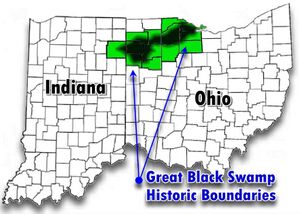1d4chan>Virulent |
|
| (9 intermediate revisions by 4 users not shown) |
| Line 1: |
Line 1: |
| [[Image:Black Swamp.jpg|right|thumb|The Great Black Swamp roughly covered the black area within the green shaded counties.]] | | [[Image:Ohio_Nuclear_Targets.jpg|right|thumb|1990 FEMA estimate of nuclear targets in Ohio]] |
|
| |
|
| The '''Great Black Swamp''', or simply '''Black Swamp''', was a [[glacier|glacial]]ly-caused [[wetland]] in [[Northwest Ohio|northwest]] [[Ohio]], [[United States]], extending into extreme northeastern [[Indiana]], that existed from the end of the [[Wisconsin glaciation]] until the late 19th century. It comprised extensive [[swamp]]s and [[marsh]]es, with some higher, drier ground interspersed, and occupied what was formerly the southwestern part of [[Glacial Lake Maumee]], a [[holocene]] precursor to [[Lake Erie]]. It was gradually drained and settled in the second half of the 19th century and is now highly productive [[farm]] land. | | [[Image:Black Swamp.jpg|right|thumb|The Great Black Swamp roughly covers the black area within the green shaded counties.]] |
|
| |
|
| Its historical boundaries lie primarily within the [[drainage basin|watershed]]s of the [[Maumee River|Maumee]], [[Auglaize River|Auglaize]], and [[Portage River|Portage]] [[river]]s in northwest Ohio. The boundary was determined primarily by ancient sandy beach ridges formed on the shores of Lakes Maumee and Whittlesey, after glacial retreat several thousand years ago. It stretched roughly from [[New Haven, Indiana]] in the west, to [[Toledo, Ohio|Toledo]] and [[Sandusky, Ohio|Sandusky]] [[Ohio]] on the east. Additional [[Drainage basin|watershed]]s partly or wholly within its former boundary include the [[Sandusky River|Sandusky]], [[Ottawa River|Ottawa]], [[Tiffin River|Tiffin]], and [[Blanchard River|Blanchard]] [[river]]s.
| | Part of the [[The_Post-Apocalyptic_Roadmap|Post-Apocalyptic Roadmap]] Project. |
|
| |
|
| The area was not continuous swamp, but rather characterized by a variety of [[vegetation]] types (Sampson, 1930; Kaatz, 1955). In the lowest, flattest areas, prone to permanent inundation, [[deciduous]] swamp forests predominated, characterized especially by species of [[ash tree|ash]], [[elm]], [[cottonwood]] and [[sycamore]]. In slightly higher areas with some topographic relief and better drainage, [[beech]], [[maple]]s, [[basswood]], [[tuliptree]] and other more [[mesic]] species were dominant. On elevated beach ridges and [[moraines]] with good to excessive drainage, more xeric species, especially of [[oak]] and [[hickory]], were dominant. Unlike other swampy areas of the Great Lakes, such as northern Minnesota, there were no [[conifer]]s (Sampson, 1930). There were also non-forested wetlands, particularly marsh and wet [[prairie]]s, with marshes being particularly extensive along the Lake Erie shoreline between Toledo and Sandusky. Some of these exist today in modified form in state and federal wildlife refuges, such as Ottawa National Wildlife Refuge. | | The state of Ohio used to be memed about as being home to all sorts of weird oddities going on and hideous creatures & malformed native residents. Nowadays, such things are no longer jokes. Ohio has become taken over by hideous mutants spilling out from the Great Black Swamp. |
| | | |
| Although much of the area to the east, south, and north was settled in the early 19th century, the difficulty of traveling through the swamp delayed its development by several decades. A [[corduroy road]] (from modern day Fremont to Perrysburg) was constructed in 1825 and paved with gravel in 1838, but travel in the wet season could still take days or even weeks. The impassability of the swamp became an obstacle during the so-called [[Toledo War]] (1835–36), when the [[Michigan]] and [[Ohio]] militias were unable to find each other, and thus were unable to battle. Settlement of the region was inhibited by the presence of endemic [[malaria]], which continued to plague residents of the region until the area was drained. In the 1850s an organized attempt to drain the swamp for agricultural use and ease of travel began which lasted for 40 years, and the area was largely settled over the next three decades. The development of railroads and a local drainage tile industry are thought to have contributed greatly to drainage and settlement (Kaatz, 1955).
| | [[Category:The Post-Apocalyptic Roadmap]] |
| | |
| ==See also==
| |
| *[[Bowling_Green,_Ohio#Black_Swamp_Arts_Festival|Black Swamp Arts Festival]]
| |
| *[[Limberlost Swamp]]
| |
| | |
| ==References==
| |
| Sampson, H.C. 1930. Succession in the swamp forest formation in northern Ohio. ''Ohio J Science'' 30:340–357.
| |
| | |
| Kaatz, M.R. 1955. The Black Swamp: A Study in Historical Geography. ''Annals of the Association of American Geographers'' 45(1):1–35.
| |
| | |
| ==External links==
| |
| *[http://wbgu.org/community/documentary/Story_GrBlack/Swamp_index.html "The Story of the Great Black Swamp"], WBGU-PBS documentary
| |
| *[http://www.historicperrysburg.org/history/swamp.htm Perrysburg history]
| |
| *[http://users.ipfw.edu/zeppp/Nature/swamp.html IPFW Black Swamp site]
| |
| *[http://www.nwoet.org/swamp/swamp.htm Swamp Survivors]
| |
| *[http://www.blackswamp.org/ The Black Swamp Conservancy] is an organization dedicated to preservation of the swamp.
| |
| *[http://www.maumeevalleyheritagecorridor.org/ Maumee Valley Heritage Corridor]
| |
| | |
| {{Ohio}}
| |
| {{Indiana}}
| |
| | |
| [[Category:Former regions and territories of the United States]] | |
| [[Category:History of Indiana]]
| |
| [[Category:History of Ohio]]
| |
| [[Category:Regions of Ohio]]
| |
| [[Category:Swamps of Indiana]]
| |
| [[Category:Swamps of Ohio]]
| |
| [[Category:Geography of Toledo, Ohio]]
| |
| | |
| [[it:Grande palude nera]]
| |

